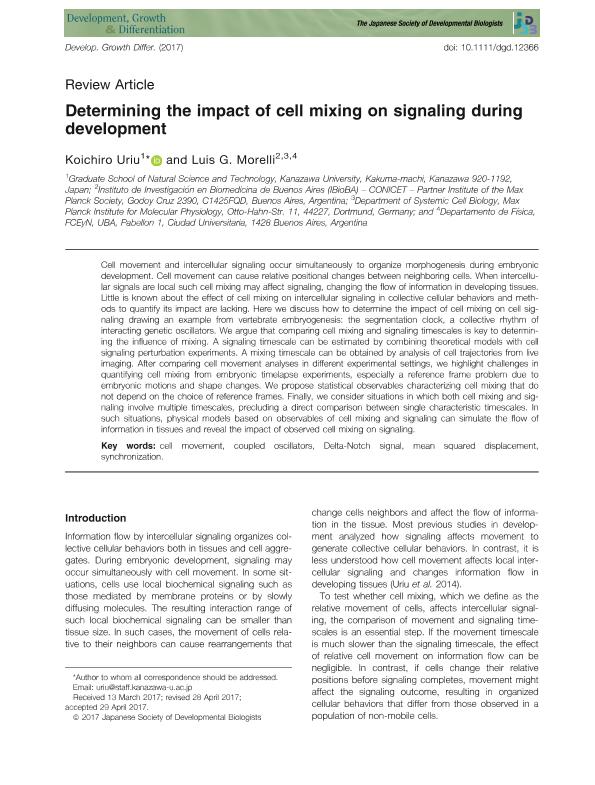Mostrar el registro sencillo del ítem
dc.contributor.author
Uriu, Koichiro
dc.contributor.author
Morelli, Luis Guillermo

dc.date.available
2018-06-19T19:20:03Z
dc.date.issued
2017-06
dc.identifier.citation
Uriu, Koichiro; Morelli, Luis Guillermo; Determining the impact of cell mixing on signaling during development; Wiley Blackwell Publishing, Inc; Development Growth & Differentiation; 59; 5; 6-2017; 351-368
dc.identifier.issn
0012-1592
dc.identifier.uri
http://hdl.handle.net/11336/49417
dc.description.abstract
Cell movement and intercellular signaling occur simultaneously to organize morphogenesis during embryonic development. Cell movement can cause relative positional changes between neighboring cells. When intercellular signals are local such cell mixing may affect signaling, changing the flow of information in developing tissues. Little is known about the effect of cell mixing on intercellular signaling in collective cellular behaviors and methods to quantify its impact are lacking. Here we discuss how to determine the impact of cell mixing on cell signaling drawing an example from vertebrate embryogenesis: the segmentation clock, a collective rhythm of interacting genetic oscillators. We argue that comparing cell mixing and signaling timescales is key to determining the influence of mixing. A signaling timescale can be estimated by combining theoretical models with cell signaling perturbation experiments. A mixing timescale can be obtained by analysis of cell trajectories from live imaging. After comparing cell movement analyses in different experimental settings, we highlight challenges in quantifying cell mixing from embryonic timelapse experiments, especially a reference frame problem due to embryonic motions and shape changes. We propose statistical observables characterizing cell mixing that do not depend on the choice of reference frames. Finally, we consider situations in which both cell mixing and signaling involve multiple timescales, precluding a direct comparison between single characteristic timescales. In such situations, physical models based on observables of cell mixing and signaling can simulate the flow of information in tissues and reveal the impact of observed cell mixing on signaling.
dc.format
application/pdf
dc.language.iso
eng
dc.publisher
Wiley Blackwell Publishing, Inc

dc.rights
info:eu-repo/semantics/openAccess
dc.rights.uri
https://creativecommons.org/licenses/by-nc-sa/2.5/ar/
dc.subject
Cell Movement
dc.subject
Coupled Oscillators
dc.subject
Delta-Notch Signal
dc.subject
Mean Squared Displacement
dc.subject
Synchronization
dc.subject.classification
Otras Ciencias Biológicas

dc.subject.classification
Ciencias Biológicas

dc.subject.classification
CIENCIAS NATURALES Y EXACTAS

dc.subject.classification
Astronomía

dc.subject.classification
Ciencias Físicas

dc.subject.classification
CIENCIAS NATURALES Y EXACTAS

dc.title
Determining the impact of cell mixing on signaling during development
dc.type
info:eu-repo/semantics/article
dc.type
info:ar-repo/semantics/artículo
dc.type
info:eu-repo/semantics/publishedVersion
dc.date.updated
2018-06-19T15:55:37Z
dc.journal.volume
59
dc.journal.number
5
dc.journal.pagination
351-368
dc.journal.pais
Reino Unido

dc.journal.ciudad
Londres
dc.description.fil
Fil: Uriu, Koichiro. Kanazawa University; Japón
dc.description.fil
Fil: Morelli, Luis Guillermo. Universidad de Buenos Aires; Argentina. Consejo Nacional de Investigaciones Científicas y Técnicas. Oficina de Coordinación Administrativa Parque Centenario. Instituto de Investigación en Biomedicina de Buenos Aires - Instituto Partner de la Sociedad Max Planck; Argentina. Institut Max Planck fur Molekulare Physiologie; Alemania
dc.journal.title
Development Growth & Differentiation

dc.relation.alternativeid
info:eu-repo/semantics/altIdentifier/doi/http://dx.doi.org/10.1111/dgd.12366
Archivos asociados
